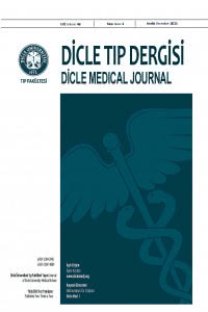Düşük prostat spesifik antijen değeri olan hastalara yapılan transrektal prostat biyopsi sonuçları
The results of transrectal prostate biopsy in patients with low levels of prostate specific antigen
___
- 1. Boyle P, Ferlay J. Cancer incidence and mortality in Europe, 2004. Ann Oncol 2005; 16(3):481-88.
- 2. Jemal A, Siegel R, Ward E, et al. Cancer statistics, 2008. CA Cancer J Clin 2008; 58(1):71-96.
- 3. Heidenreich A, Bellmunt J, Bolla M, et al. EAU guidelines on prostate cancer. Part 1: screening, diagnosis, and treatment of clinically localised disease. European urology 2011; 59(1):61-71.
- 4. Cooner WH, Mosley BR, Rutherford CL, Jr., et al. Prostate cancer detection in a clinical urological practice by ultrasonography, digital rectal examination and prostate specific antigen. J Urol 1990; 143(8):1146-52.
- 5. Catalona WJ, Smith DS, Ratliff TL, et al. Detection of organconfined prostate cancer is increased through prostate-specific antigen-based screening. JAMA 1993; 270(7):948-54.
- 6. Mettlin C, Lee F, Drago J, et al. The American Cancer Society National Prostate Cancer Detection Project. Findings on the detection of early prostate cancer in 2425 men. Cancer 1991; 67(11):2949-58.
- 7. Colberg JW, Smith DS, Catalona WJ. Prevalence and pathological extent of prostate cancer in men with prostate specific antigen levels of 2.9 to 4.0 ng./ml. J Urol 1993; 149(3):507-09.
- 8. Lodding P, Aus G, Bergdahl S, et al. Characteristics of screening detected prostate cancer in men 50 to 66 years old with 3 to 4 ng./ml. Prostate specific antigen. J Urol 1998; 159(6):899-903.
- 9. Catalona WJ, Smith DS, Ratliff TL, et al. Measurement of prostate-specific antigen in serum as a screening test for prostate cancer. N Engl J Med 1991; 324(9):1156-61.
- 10. Schroder FH, van der Cruijsen-Koeter I, de Koning HJ, et al. Prostate cancer detection at low prostate specific antigen. J Urol 2000; 163(6):806-12.
- 11. Carter HB, Pearson JD. Prostate-specific antigen testing for early diagnosis of prostate cancer: formulation of guidelines. Urology 1999; 54:780-6.
- 12. Catalona WJ, Hudson MA, Scardino PT, et al. Selection of optimal prostate specific antigen cutoffs for early detection of prostate cancer: receiver operating characteristic curves. J Urol 1994; 152(11):2037-42.
- 13. Ross KS, Carter HB, Pearson JD, et al. Comparative efficiency of prostate-specific antigen screening strategies for prostate cancer detection. JAMA 2000; 284(8):1399-405.
- 14. Morgan TO, Jacobsen SJ, McCarthy WF, et al. Age-specific reference ranges for prostate-specific antigen in black men. N Engl J Med 1996; 335(2):304-10.
- 15. Altunoluk B, Bahar MR, Eren M, et al. Evaluation of the role of digital rectal examination and prostate specific antigen in diagnosis of prostate cancer J Clin Exp Invest 2012; 3(1):66-70.
- 16. Catalona WJ, Smith DS, Ornstein DK. Prostate cancer detection in men with serum PSA concentrations of 2.6 to 4.0 ng/mL and benign prostate examination. Enhancement of specificity with free PSA measurements. JAMA 1997; 277:1452-55.
- 17. Gilbert SM, Cavallo CB, Kahane H, et al. Evidence suggesting PSA cutpoint of 2.5 ng/mL for prompting prostate biopsy: review of 36,316 biopsies. Urology 2005; 65(3):549-53.
- 18. Thompson IM, Pauler DK, Goodman PJ, et al. Prevalence of prostate cancer among men with a prostate-specific antigen level _____ or =4.0 ng per milliliter. N Engl J Med 2004; 350(10):2239-46.
- 19. Thompson IM, Ankerst DP, Chi C, et al. Operating characteristics of prostate-specific antigen in men with an initial PSA level of 3.0 ng/ml or lower. JAMA 2005; 294(1):66- 70.
- 20. Leite KR, Srougi M, Dall’Oglio MF, et al. Histopathological findings in extended prostate biopsy with PSA _____ or = 4 ng/mL. Int Braz J Urol 2008; 34(3):283-90.
- ISSN: 1300-2945
- Yayın Aralığı: 4
- Başlangıç: 1963
- Yayıncı: Cahfer GÜLOĞLU
Hafize SAV, Mustafa Altay ATALAY, Mehmet YÜCESOY, Duygu PERÇİN
Tıbbi araştırmalarda güvenilirlik ve geçerlilik
Ahmet ACEMOĞLU, Zekeriya AKTÜRK
Insulin hormone: Mechanism and effects on the body and relationship with central nervous system
Deniz ÜNAL, Adem KARA, SELİNA AKSAK KARAMEŞE, B. Zuhal ALTUNKAYNAK, Serap YILDIRIM
Anesthesia management for pregnant patient with Arnold-Chiari malformation type I: A case report
Ahmet KÜÇÜK, Hasan Hüsnü YÜCE, Harun AYDOĞAN, Mahmut Alp KARAHAN, Şaban YALÇIN, Mehmet VURAL
Salih HOŞOĞLU, FATMA BOZKURT, Recep TEKİN, Celal AYAZ, Mehmet Faruk GEYİK
Seydi OKUMUŞ, Erol COŞKUN, Mehmet Gürkan TATAR, Burak ÖREN, Pelin ÇELEMLER, Erdal KAYDU, İbrahim ERBAĞCI, Bülent GÜRLER
Konya il merkezinde sağlıkta dönüşüm öncesi ve sonrası gebe ve bebek izlemleri
YASEMİN DURDURAN, Said BODUR, Enver ÇAKIL, Emel FİLİZ
Reliability and validity in medical research
Hamit ACEMOĞLU, Zekeriya AKTÜRK
Petröz apeks kolesteatomu: Olgu sunumu
Ediz YORGANCILAR, Vefa KIRIŞ, Müzeyyen YILDIRIM, Salih BAKIR, Musa ÖZBAY, Faruk MERİÇ
Long-term results of percutaneous endoscopic gastrostomies
MURAT ÇAKIR, Ahmet TEKİN, Tevfik KÜÇÜKKARTALLAR, İLHAN ÇİFTCİ, Celalettin VATANSEV, Faruk AKSOY, Adil KARTAL
